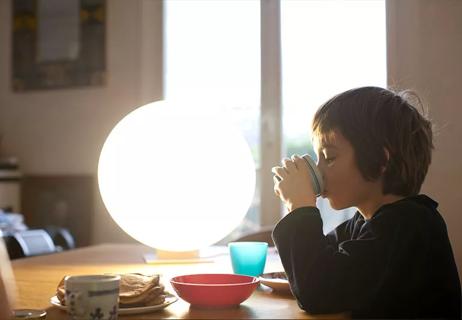Light therapy can boost sleep and help fight depression

The dark, cold winter months can take a toll on your mental health. If you’re sleeping too much, feeling depressed or have your days and nights mixed up during the winter months, you might want to consider using a sun lamp.
Advertisement
Cleveland Clinic is a non-profit academic medical center. Advertising on our site helps support our mission. We do not endorse non-Cleveland Clinic products or services. Policy
The light delivered through sun lamps is often particularly effective for people suffering from seasonal affective disorder (SAD), according to family medicine practitioner Robert Cain, MD.
“Long periods of dark and a lack of sun exposure gets your sleep-wake rhythm thrown off and sun lamps help reset it,” says Dr. Cain.
Sun lamps positively impact your body’s regulation of melatonin, a hormone that helps control your sleep-wake cycle, as well as serotonin, which helps regulate your mood by relaying signals in your brain. One study reports that bright-light therapy is now considered to be the first line of treatment for SAD.
No prescription is necessary for a sun lamp. Sun lamps are available at many retail stores for a variety of different price points.
“Any doctor who treats depression — a primary care provider, psychiatrist or psychologist — can recommend light therapy, but you don’t need a prescription to buy a sun lamp,” says Dr. Cain.
If you are considering trying sun lamp therapy, it’s a good idea to talk to your doctor about whether it’s right for you. If you do decide to buy one, look for a sun lamp with bright, white light. The Skin Cancer Foundation reports that full-spectrum light and blue light provides no known therapeutic advantage and causes glare.
Advertisement
“Sun lamps don’t give off ultraviolet radiation, so they pose little risk to most people,” says Dr. Cain. “Be sure to ask your doctor if any medication you take makes you more sensitive to light.”
Avoid using one if you have:
If you have bipolar disorder, Dr. Cain recommends using a mood stabilizer with a sun lamp because the added light exposure can cause a manic episode. Children can suffer from SAD, too. While there are other effective treatments to treat SAD, talk to their doctor about sun lamp therapy and if this treatment would be the best route for your child.
“If a child has been diagnosed with depression, I wouldn’t hesitate to recommend it,” he says. “I think it’s pretty safe. Just make sure they don’t look directly at the light.”
No matter if you use a small sun lamp for your desk or one that you extend from the ground, position the lamp about two to three feet away from you. Never look directly into the light.
It’s common to see improvement in your mood within two to four days if you use a 10,000 lux bulb for about 30 minutes every morning.
“Light therapy via sun lamps is most effective in the mornings,” says Dr. Cain.”Try to use the lamp daily while you eat breakfast or have coffee.”
Even though it’s a light-based therapy, sun lamps don’t impact vitamin D production. Be sure to get your vitamin D through your diet and/or supplements as your doctor advises.
Sunrise alarm clocks are similar to sun lamps.
“These devices are basically alarm clocks that you set to mimic the sunrise,” says Dr. Cain. “They don’t emit UV rays and have equal efficacy to sun lamps. For maximum benefit, set the clock to resemble a sunrise in June or July.”
Your eyes can absorb the light through your eyelids, so you wake up gradually and may take care of your light therapy before you even get out of bed.
All in all, sun lamps can do wonders for your SAD. Remember to work with your doctor to keep them updated on your progress.
Advertisement
Learn more about our editorial process.
Advertisement

If you experience warm weather seasonal depression, you’re not alone

Cozying up with friends and family can make cold, dark days more meaningful

An expert explains how seasonal weather changes affect our health

We shine a light on how light therapy can improve your mood

Helpful tips to ward off the winter blues

Plus, helpful tips for managing SAD during these challenging times

It’s critical to have the proper eyewear if you plan to look up at the sun, especially during the total solar eclipse on April 8, 2024

The same things you do to treat sore muscles after exercise can help treat soreness after a massage

Type 2 diabetes isn’t inevitable with these dietary changes

Applying a hot or cold compress can help with pain